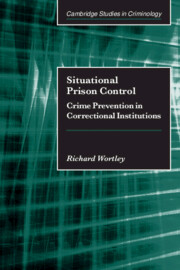Book contents
- Frontmatter
- Contents
- List of figures and tables
- Foreword
- Acknowledgements
- Part I Theoretical foundations
- Part II Specific behaviours
- 5 Prisoner-prisoner violence
- 6 Sexual assaults
- 7 Prisoner-staff violence
- 8 Self-harm
- 9 Drug use
- 10 Escapes
- 11 Collective disorder
- 12 Conclusions: hard and soft situational prison control
- List of references
- Index
9 - Drug use
Published online by Cambridge University Press: 22 September 2009
- Frontmatter
- Contents
- List of figures and tables
- Foreword
- Acknowledgements
- Part I Theoretical foundations
- Part II Specific behaviours
- 5 Prisoner-prisoner violence
- 6 Sexual assaults
- 7 Prisoner-staff violence
- 8 Self-harm
- 9 Drug use
- 10 Escapes
- 11 Collective disorder
- 12 Conclusions: hard and soft situational prison control
- List of references
- Index
Summary
Drug use in prison has become one of the major control issues facing prison administrators in recent years. The problem of drugs in prison parallels the problem of drugs in the community. That is, the concern is not just that the use of drugs is illegal but that drugs are associated with a range of other crime and health problems. Drugs form the basis of the prisoner economy and are a significant cause of gang conflicts and prisoner violence, as well as staff corruption (Correctional Service of Canada, 1989: 13–14; Fleisher and Rison, 1999: 234–5; Kalinich and Stojkoviv, 1987: 11; MacDonald, 1999; Select Committee on Home Affairs, 1999: 4–6 Section B). In addition, the use of intravenous drugs in prison has implications for the spread of HIV/AIDS (Dolan et al., 1998; Edwards et al., 1999; Ross et al., 1994).
Nature of the problem
Definition and incidence
The drug problem in prison includes the use and trafficking of illegal drugs such as heroin, cocaine and marijuana, prescription drugs and alcohol, as well as the misuse of legal substances such as glues and fruit juices. There is a widespread perception that drug use is endemic in prisons. However, it is difficult to get accurate figures on use, with estimates varying widely across studies. To some extent, of course, such variations reflect true differences in drug-use patterns among institutions.
- Type
- Chapter
- Information
- Situational Prison ControlCrime Prevention in Correctional Institutions, pp. 155 - 172Publisher: Cambridge University PressPrint publication year: 2002



